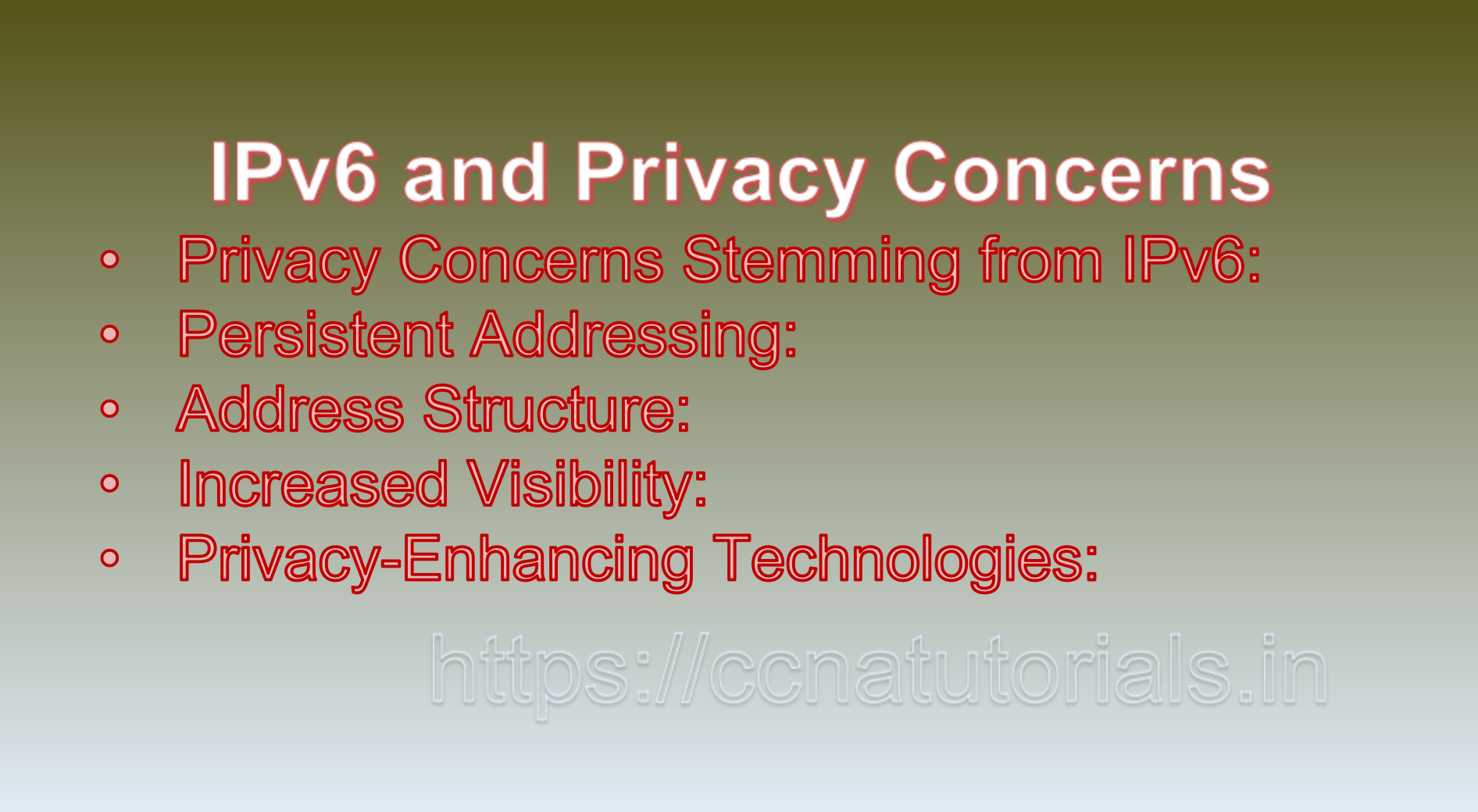Contents of this article
In this article, I describe IPv6 and Privacy Concerns Navigating the Balance Between Connectivity and Confidentiality. Internet Protocol version 6 (IPv6) represents a significant advancement in internet technology, addressing the limitations of its predecessor, IPv4, and providing a larger address space to accommodate the ever-expanding number of connected devices. However, alongside its benefits, IPv6 brings about important privacy concerns that arise from its unique addressing structure and increased visibility of devices. This article explores the intersection of IPv6 and privacy concerns, highlighting the challenges and potential solutions to strike a balance between seamless connectivity and individual confidentiality.
1. Understanding IPv6 and Its Addressing Scheme:
IPv6 employs a 128-bit addressing scheme, offering an immense pool of unique addresses to support the growing number of devices, services, and users on the internet. Unlike IPv4, which used 32-bit addresses, IPv6 allocates a significantly larger number of addresses, facilitating efficient device connection and enabling the Internet of Things (IoT) revolution.
2. Privacy Concerns Stemming from IPv6:
While IPv6 addresses are necessary to enable seamless communication, they introduce privacy implications due to their unique characteristics:
– Persistent Addressing: IPv6 addresses assigned to devices can remain relatively stable over time, leading to long-term tracking of user activities across various online platforms. This persistence raises concerns about user privacy and the potential for unauthorized surveillance.
– Address Structure: IPv6 addresses often include identifiable information, such as the network’s organization or the device’s manufacturer. This feature could enable third parties to gather information about users’ online behavior, compromising anonymity.
– Increased Visibility: IPv6’s larger address space allows a broader range of devices to be connected directly to the internet without the need for Network Address Translation (NAT). This increased visibility makes devices more susceptible to scans, potentially exposing them to security threats.
3. Privacy Challenges and Potential Solutions:
– User Anonymity: With the proliferation of IPv6 addresses, preserving user anonymity becomes challenging. One solution involves regularly changing or randomizing IPv6 addresses, hindering long-term tracking.
– Privacy-Enhancing Technologies: Utilizing privacy-enhancing technologies, such as IPv6 Privacy Extensions, can generate temporary addresses for devices, limiting the time window during which user activities can be tracked.
– Network-Level Privacy Policies: Organizations and internet service providers (ISPs) can implement network-level policies that define how long an IPv6 address can remain associated with a specific device, mitigating long-term tracking.
4. Example: Mobile Networks and IPv6 Privacy:
In mobile networks, the adoption of IPv6 can have significant privacy implications. Mobile devices typically have unique identifiers associated with their IPv6 addresses, potentially linking users’ online activities across various apps and services. This scenario raises concerns about user tracking and data harvesting.
Solution:
Mobile operating systems have implemented IPv6 Privacy Extensions, which periodically generate temporary IPv6 addresses for outgoing traffic. This rotation mechanism ensures that user activities are less susceptible to long-term tracking. For instance, iOS and Android devices utilize temporary addresses to enhance user privacy while maintaining connectivity.
5. User Education and Control:
Empowering users with information about IPv6 privacy concerns and providing them with control over their online presence are essential steps toward addressing privacy challenges:
– Privacy Settings: Operating systems and applications can provide users with settings to manage their IPv6 privacy preferences, allowing them to opt for temporary addresses and control the frequency of address rotation.
– Privacy Awareness Campaigns: Educational campaigns can inform users about IPv6’s impact on privacy and guide them in making informed decisions about their online activities.

In sort IPv6 and Privacy Concerns, Striking the Balance:
IPv6’s advancements pave the way for a more connected and efficient digital world. However, as with any technological progression, it brings about privacy challenges that need to be addressed. Organizations, service providers, and users must collaborate to find solutions that preserve the benefits of IPv6 while respecting individuals’ right to privacy. By implementing privacy-enhancing technologies, educating users, and offering granular control over privacy settings, the digital ecosystem can evolve into one that is both connected and respectful of personal confidentiality. As we navigate the future of networking, it is crucial to prioritize the harmony between connectivity and privacy, ensuring that technological progress does not come at the cost of individual rights and security.
IPv6 and Privacy Concerns: Striking a Balance Between Connectivity and Personal Privacy
Internet Protocol version 6 (IPv6) has emerged as the next-generation internet protocol designed to address the limitations of IPv4, primarily the exhaustion of available IP addresses. While IPv6 brings significant advancements in terms of address space and network efficiency, its adoption also raises privacy concerns due to the inherent changes in address assignment and identification. This article explores the intersection of IPv6 and privacy concerns, highlighting the potential challenges and strategies to mitigate privacy risks while maintaining the benefits of this protocol.
1. IPv6 and its Addressing Mechanism:
IPv6 introduces a 128-bit address space, a dramatic increase from IPv4’s 32-bit space, allowing for trillions of unique addresses. This expansion enables the proliferation of internet-connected devices and supports emerging technologies like the Internet of Things (IoT). However, IPv6’s addressing mechanism also raises concerns related to user identification and privacy:
– Global Unicast Addresses: IPv6’s global unicast addresses, unlike IPv4’s dynamic IP assignments, often remain constant for long periods. This persistence can facilitate long-term tracking of user activities.
– Autoconfiguration: IPv6 incorporates stateless address autoconfiguration, allowing devices to self-assign addresses based on network prefixes. While this enhances efficiency, it can also expose devices to network scanning and enumeration.
2. Privacy Concerns Arising from IPv6:
IPv6’s addressing and identification mechanisms can give rise to several privacy challenges:
– Device Fingerprinting: Persistent IPv6 addresses can be used to uniquely identify devices and track their online activities across different networks and locations, potentially enabling detailed device fingerprinting.
– Location Tracking: Long-lived IPv6 addresses can reveal users’ physical locations over extended periods, creating concerns about user privacy and personal security.
– Network Enumeration: Stateless autoconfiguration can lead to predictable address patterns, making it easier for malicious actors to scan and identify devices on a network.
3. Mitigating IPv6 Privacy Concerns:
While IPv6’s features can raise privacy concerns, there are strategies and best practices to mitigate these risks:
– Temporary Addresses: IPv6 allows devices to use temporary addresses for outgoing connections, which change periodically. These temporary addresses enhance privacy by making it more difficult to track individual devices consistently.
– Privacy Extensions: Many operating systems support privacy extensions, where devices generate random temporary addresses in addition to their fixed addresses. This helps obfuscate long-term tracking.
– Network Design: Network administrators can segment networks and employ firewalls to limit the visibility of devices within a subnet, making it harder for external parties to enumerate and track devices.
– IPsec and Encryption: IPv6 mandates the inclusion of IPsec for secure communication. Organizations can leverage IPsec for encrypting traffic, enhancing data privacy and confidentiality.
4. Example: IPv6 Privacy Extensions in Action:
Modern operating systems often incorporate IPv6 privacy extensions to mitigate privacy risks. Let’s consider the example of Windows operating systems:
Implementation:
– Windows includes IPv6 privacy extensions by default. Devices generate temporary addresses alongside their global unicast addresses.
Impact:
– Temporary addresses offer a layer of privacy protection by preventing long-term tracking based on fixed addresses. As temporary addresses change periodically, it becomes more challenging to correlate online activities with a specific device.
5. IPv6 and GDPR Compliance:
The General Data Protection Regulation (GDPR) is a comprehensive privacy regulation that impacts the way organizations handle personal data. While IPv6 adoption doesn’t inherently conflict with GDPR, organizations must ensure that their IPv6 implementations align with the regulation’s principles:
– Data Minimization: Organizations should assess whether the collection of IPv6 addresses is necessary for the services they provide. Avoid retaining unnecessary data to minimize privacy risks.
– Purpose Limitation: Clearly communicate the purpose for which IPv6 addresses are collected and used. Ensure that data processing aligns with the intended purpose and complies with user consent.
– User Rights: Under GDPR, users have rights regarding their personal data, including the right to access, rectify, and erase their information. Organizations must be prepared to fulfill these requests, even in the context of IPv6 addresses.
Conclusion for IPv6 and Privacy Concerns, Balancing Connectivity and Privacy:
IPv6’s adoption offers substantial benefits for the internet’s growth and technological advancement. However, it’s essential to recognize and address the privacy concerns that arise due to its unique addressing mechanism. Organizations and individuals should implement best practices and strategies, such as temporary addresses and privacy extensions, to mitigate the risks associated with persistent addressing and tracking. Compliance with regulations like GDPR ensures that IPv6 adoption aligns with user privacy rights. By finding the right balance between connectivity and privacy, the industry can fully harness IPv6’s potential while safeguarding individuals’ personal information in an increasingly connected world.






